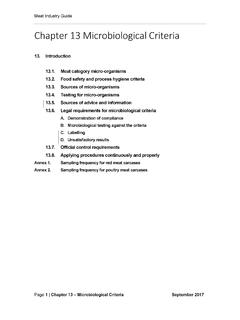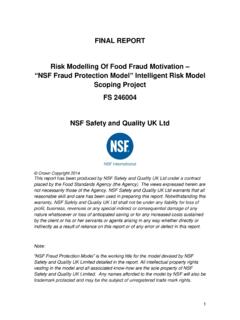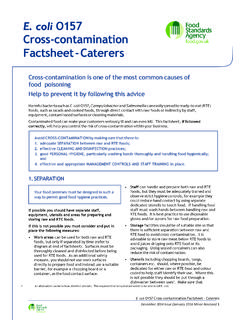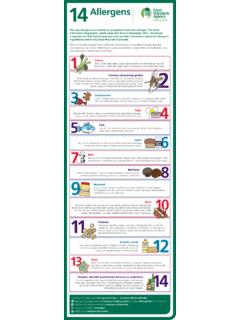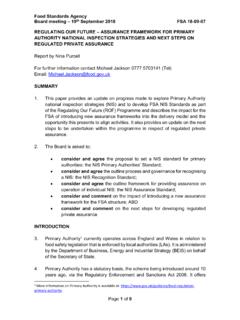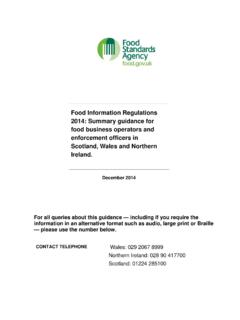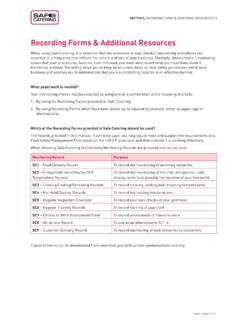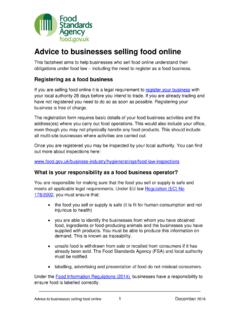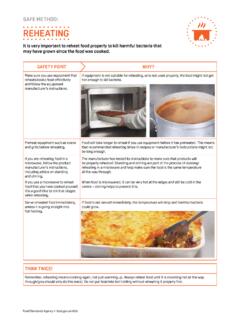Transcription of Chapter 1 Introduction - food.gov.uk
1 Meat Industry Guide Page 1 | Chapter 1 Introduction April 2018 Chapter 1 Introduction 1. Introduction to the Meat Industry Guide (MIG) Regulation and legislation Approval of fresh meat establishments Hazards in meat production Definitions Abbreviations Useful contacts Meat Industry Guide Page 2 | Chapter 1 Introduction April 2018 1. Introduction to the Meat Industry Guide (MIG) The Meat Industry Guide (MIG) contains legislation to which food business operators (FBOs), authorised officers and policy makers may refer for information and a widely agreed view of good practice.
2 Who should use the MIG? Guidance in the MIG is aimed at both new and established businesses involved in the slaughter, cutting and processing of fresh meat, and especially those subject to veterinary control by the Food Standards Agency (FSA) in England & Wales, Food Standards Scotland (FSS), or the Department of Agriculture, Environment and Rural Affairs (DAERA) in Northern Ireland. The MIG should be particularly helpful if you are a prospective food business seeking an approval to start such operations. There is no legal requirement for FBOs to follow the advice contained in the MIG as FBOs may demonstrate compliance with the legislation in other ways.
3 Where an FBO is following the guidance in a recognised industry guide, such as this one, the enforcement authority must take this into account when assessing compliance with the legislation. What does the MIG contain? The MIG provides non-binding advice and guidance on the legal requirements of the EU Food Hygiene Regulations that apply to FBOs in the meat sector and provides advice on how these obligations can be met. The MIG should be read in conjunction with the legislation itself and the text should not be taken as an authoritative statement or interpretation of the law, as only the courts have this power.
4 Operations covered in the MIG include: slaughter and dressing of red meat species slaughter and dressing of poultry and rabbits slaughter and dressing of farmed game dressing of wild game in game handling establishments cutting of red, white or game meat production of meat products, minced meat, meat preparations and mechanically separated meat (MSM) How to use the MIG Every effort has been made to make sure that the MIG is helpful to FBOs. Food hygiene legislation emphasises every FBOs responsibility to produce food safely by applying good hygienic practices and food safety management procedures based on hazard analysis and critical control point (HACCP) principles.
5 Each Chapter follows a standard format and contains information presented according to the following categories: Meat Industry Guide Page 3 | Chapter 1 Introduction April 2018 Legal requirement relevant extracts from Food Standard legislation with which FBOs must comply. This information is displayed in green boxes. Compliance actions which must be completed by FBOs in order to comply with the relevant legislation. This information is identified by an orange heading. Good practice recommended methods by which the compliance actions may be undertaken.
6 Good practice information is displayed under a yellow heading. Tips useful information for FBOs about how to implement specific compliance actions. This information is presented in TIP boxes, identified by a green arrow. Flexibilities alternative means by which to comply with legal requirements, which take account of different contexts and situations. Flexibilities are presented in blue boxes. Changes and revisions to the MIG will be detailed within the revision history document held by the FSA Feedback The FSA would like to thank everyone involved in producing the MIG.
7 If you have any suggested amendments or feedback, please get in touch with us by email: or write to us at: Guidance and Training Team Food Standards Agency 1st floor - Foss House Peasholme Green York YO1 7PR Meat Industry Guide Page 4 | Chapter 1 Introduction April 2018 Regulation and legislation The production, processing, distribution, retail, packaging and labelling of food stuffs are governed by laws, regulations, codes of practice and guidance. Detailed information can be found at: An up to date list of legislation can be found in the MOC, volume two at: European Union Regulations The table overleaf provides details of relevant EU Regulations that apply to all EU Member States and links to associated guidance documents.
8 It also sets out the domestic implementing regulations that allow for the application of the EU legislation across GB and relevant applicable domestic legislation. Additional information can be found on the FSA website at: UK Food Safety and Hygiene Regulations The regulations make provision for the enforcement and execution of the EU Hygiene Regulations and the EU Food Safety Regulations. They provide enforcement powers (for example, powers of entry, the service of formal notices, such as: hygiene improvement notices; hygiene prohibition orders; hygiene emergency prohibition notices and orders; remedial action notices and detention notices and appeals against such notices), set out enforcement responsibilities, time limits for bringing prosecutions and penalties available to the courts for a contravention of the legal requirements.
9 UK Legislation can be located at: These regulations provide that a person who contravenes or fails to comply with specified provisions of Regulation (EC) No. 852/2004 or Regulation (EC) No. 853/2004 is guilty of an offence, but also provides a defence, where the accused can prove that they took all reasonable precautions and exercised all due diligence to avoid the commission of the offence. The Hygiene Regulations provide FBOs with flexibilities for meeting the requirements of the legislation through the use of words such as 'adequate', sufficient and equivalent.
10 Additional information on flexibilities can be found at: Enforcement policy The FSA Operations Group Enforcement Policy is set out in the Manual for Official Controls (MOC) available at: The DAERA Veterinary Service Prosecution Policy is set out in the Prosecutions Policy booklet and referred to in the Manual for Official Controls: Meat Industry Guide Page 5 | Chapter 1 Introduction April 2018 Subject EU Regulations EU and Domestic Guidance Implementing regulations or applicable domestic legislation Food safety Regulation (EC) 178/2002 General Requirements of Food Law Commission Implementing Regulation (EU) 931/2011 FSA guidance notes for FBOs on food safety, traceability, product withdrawal and recall (a guide to compliance with Articles 14, 16, 18 and 19 of Regulation (EC) 178/2002).
